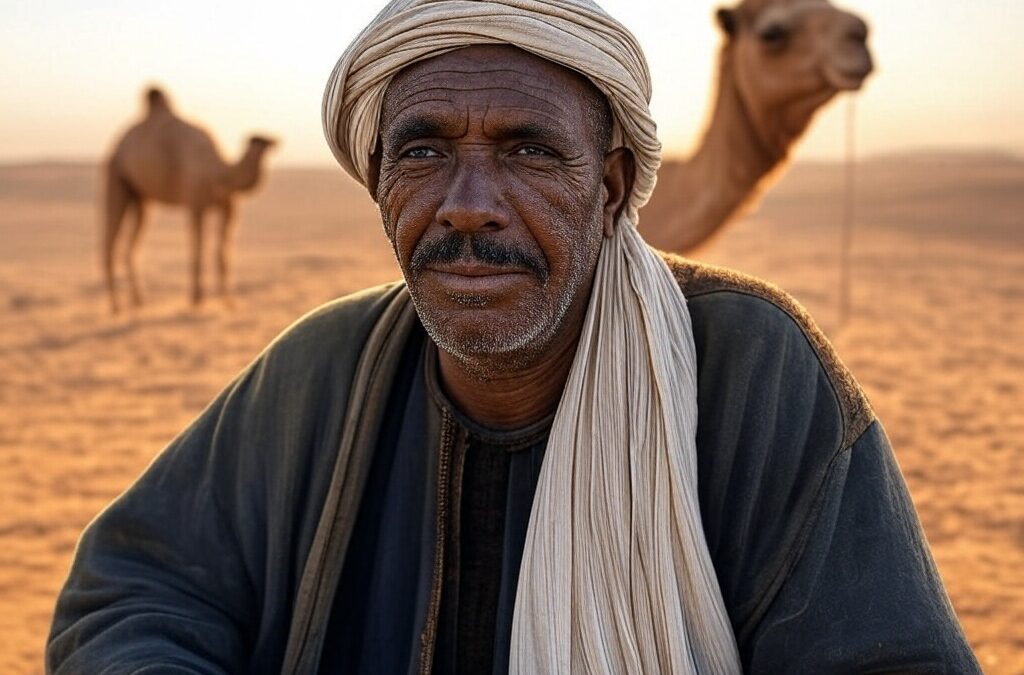Imagine waking up to the sound of waves crashing on a beach in Thailand one week and then sipping coffee in a bustling café in Paris the next. This is the reality for many nomads who have embraced a life without borders, choosing to live and work wherever their hearts take them. In a world where traditional workspaces are becoming less necessary, more people are discovering the freedom and adventure that come with a nomadic lifestyle. The idea of owning only what fits in a backpack and letting curiosity guide your journey is both exciting and liberating.
Nomadic life isn’t just about travel; it’s about a mindset that values experiences over possessions. From digital nomads working remotely to traditional nomadic communities that have thrived for centuries, there are countless ways people live on the move. Some find their calling in the vibrant streets of big cities, while others seek solitude in nature’s remote corners. This article explores 20 unique examples of nomadic living, showcasing the diverse paths people take when they choose to live a life less ordinary. Whether you’re dreaming of hitting the road or just curious about this way of life, these stories offer a glimpse into the endless possibilities of living without permanent roots.
What is Nomadism?
Nomadism is a lifestyle characterized by constant movement rather than permanent residence in one location. Traditionally, it refers to communities that travel seasonally to find resources such as food, water, and grazing land, often seen in pastoral, hunter-gatherer, and trader societies. In the modern context, nomadism has evolved into digital nomadism, where individuals leverage technology to work remotely while traveling. This lifestyle prioritizes mobility, adaptability, and minimalism, with nomads often living in temporary accommodations such as tents, RVs, or co-living spaces. Whether traditional or digital, nomadism is deeply tied to freedom, exploration, and the ability to adapt to changing environments.
Nomadism has played a crucial role in human history, shaping cultures, economies, and migration patterns. Traditional nomadic groups, such as the Bedouins of the Middle East, the Maasai of East Africa, and the Mongols of Central Asia, have thrived for centuries by developing sustainable practices suited to their environments. These groups often rely on oral traditions, strong social bonds, and a deep understanding of nature to navigate their way of life.
In the modern era, digital nomadism has gained popularity due to advances in technology, remote work opportunities, and a growing desire for location independence. Digital nomads typically work online in fields such as freelancing, consulting, e-commerce, and content creation, allowing them to travel freely while maintaining a source of income. Popular destinations for digital nomads include cities with affordable living costs, strong internet connectivity, and vibrant expat communities, such as Bali, Chiang Mai, and Lisbon.
Despite its appeal, nomadism comes with challenges. Traditional nomads often face land rights issues, climate change impacts, and governmental restrictions that threaten their way of life. Digital nomads, on the other hand, must navigate visa regulations, fluctuating income, and the lack of stability that comes with constant movement. Additionally, the mental and emotional toll of a transient lifestyle can lead to loneliness and burnout.
However, for those who embrace it, nomadism offers unparalleled freedom, personal growth, and cultural immersion. It encourages adaptability, self-reliance, and a minimalist mindset, helping individuals break free from conventional societal structures. Whether driven by necessity, adventure, or a search for a better work-life balance, nomadism continues to be a dynamic and evolving way of life that challenges traditional notions of home and stability.
The Best Examples of Nomadic Life
Nomadic life exists in many different forms, from ancient cultures that have moved with the seasons for centuries to modern travelers working remotely from anywhere in the world. Across different regions and lifestyles, people have found ways to live and thrive without settling in one place. Below are 20 fascinating examples of nomadic living, showing how individuals and communities continue to adapt to a life on the move.
1. The Mongolian Steppe Nomads
In Mongolia, traditional nomads still roam the vast steppes. They move with their herds of sheep, goats, and horses, living in portable yurts. This lifestyle is deeply connected to the land and seasons, relying on ancient traditions to sustain their way of life.
2. The Bedouins of the Arabian Desert
The Bedouins are known for their adaptability to harsh desert conditions. They live in tents and migrate to find water and grazing for their camels. Their culture is rich with oral poetry and music, reflecting their deep connection to the desert environment.
3. The Sami Reindeer Herders
In the Arctic regions of Norway, Sweden, and Finland, the Sami people follow their reindeer herds. Their nomadic life is intertwined with the harsh, yet beautiful, Arctic landscape. The Sami have a unique language and cultural practices that revolve around reindeer herding.
4. The Maasai of East Africa
The Maasai people of Kenya and Tanzania are semi-nomadic pastoralists. They move their cattle in search of pasture and water, living in temporary settlements. The Maasai are known for their distinctive dress and vibrant cultural ceremonies.
5. The Tuareg of the Sahara
The Tuareg, often referred to as the “Blue People” for their indigo-dyed clothing, traverse the vast Sahara Desert. They are skilled traders and guides, navigating the challenging desert terrain. Their lifestyle is a blend of tradition and adaptation to modern challenges.
6. The Romani Travelers
The Romani people, often known as gypsies, have a long history of a nomadic lifestyle. They travel across Europe in caravans, maintaining a rich tradition of music and dance. Despite facing discrimination, they continue to preserve their cultural identity.
7. The Fulani Herdsmen of West Africa
The Fulani are one of the largest nomadic groups in the world. They traverse the Sahel and savannah regions with their cattle. Their life is centered around the rhythms of pastoralism, moving to ensure their herds have sufficient grazing land.
8. The Sea Nomads of Southeast Asia
The Bajau people, often called Sea Gypsies, live a unique nomadic life on the waters of Southeast Asia. They spend most of their lives at sea, living on boats and relying on fishing and diving for sustenance. Their deep connection to the ocean is evident in their way of life.
9. The Indigenous Tribes of the Amazon
Many indigenous tribes in the Amazon rainforest practice a semi-nomadic lifestyle. They move to different parts of the forest to hunt, gather, and farm. Their knowledge of the forest is extensive, and they live in harmony with the natural environment.
10. The Digital Nomads
In contrast to traditional nomads, digital nomads use technology to work remotely while traveling the world. They might settle in one place for a few months before moving on. This lifestyle offers freedom and flexibility, appealing to those who seek adventure and new experiences without being tied to a single location.
11. The Nenets of Siberia
The Nenets people, residing in the Siberian tundra, are reindeer herders who migrate vast distances across the frozen landscape. Their lives are intricately tied to the harsh climate, requiring resilience and deep knowledge of the environment. The Nenets’ traditions and spiritual beliefs are closely linked to their nomadic lifestyle, maintaining their cultural heritage amidst modern pressures.
12. The Berbers of North Africa
Berbers, or Amazigh people, have a history of nomadism in the mountainous and desert regions of North Africa. They traditionally move with their livestock, adapting to the seasonal changes in search of grazing lands. Their rich cultural tapestry includes a unique language and vibrant artistic expressions, reflecting a deep connection to their ancestral land.
13. The Rashaida of the Horn of Africa
Originating from the Arabian Peninsula, the Rashaida people have settled in parts of Eritrea and Sudan. They lead a nomadic lifestyle centered around camel herding, navigating the arid landscapes of the Horn of Africa. Known for their distinctive red and black clothing, the Rashaida maintain a strong sense of identity and cultural pride.
14. The Himba of Namibia
In the arid regions of northern Namibia, the Himba people live as semi-nomadic pastoralists. They move with their cattle between seasonal grazing grounds, relying on the land for sustenance. The Himba are renowned for their unique hairstyles and ochre-colored skin, which are integral to their cultural identity.
15. The Tibetan Nomads
High on the Tibetan Plateau, nomadic groups such as the Khampas and Drogpas herd yaks and sheep. Their way of life is shaped by the extreme altitude and climatic conditions, requiring adaptation and resourcefulness. Tibetan nomads have a rich spiritual tradition, with Buddhism playing a central role in their daily lives.
16. The Qashqai of Iran
The Qashqai people of Iran are known for their vibrant culture and intricate woven textiles. They migrate seasonally across the Zagros Mountains, herding sheep and goats. Despite facing challenges from modernization, the Qashqai strive to preserve their nomadic traditions and cultural heritage.
17. The Dukha of Mongolia
The Dukha, also known as the Tsaatan, are reindeer herders living in the taiga forests of northern Mongolia. Their nomadic lifestyle is closely connected to their reindeer, which provide transportation, milk, and companionship. The Dukha’s intimate relationship with nature is reflected in their shamanistic practices and deep respect for the land.
18. The Wodaabe of Niger
The Wodaabe are a subgroup of the Fulani, renowned for their annual Gerewol festival, a celebration of beauty and courtship. They lead a nomadic existence in the Sahel, herding cattle across expansive grasslands. The Wodaabe’s rich cultural traditions, including elaborate costumes and dances, are a testament to their enduring way of life.
19. The Ainu of Japan
While traditionally not nomadic, the Ainu people of Japan had a semi-nomadic lifestyle centered around fishing, hunting, and gathering. Their close relationship with nature is evident in their spiritual beliefs and rituals. Despite historical challenges, the Ainu continue to preserve their unique cultural identity and traditions.
20. The Irish Travellers
Irish Travellers are a distinct ethnic group with a long history of itinerant living. They travel in caravans, often working as tradespeople and craftsmen. Despite facing social challenges and discrimination, Irish Travellers maintain a vibrant oral tradition and a strong sense of community, reflecting their resilience and adaptability.
Nomadic Lifestyle: Historical Context and Cultural Significance
Nomadic life has been an integral part of human history, with groups of people moving from place to place in search of food, water, and grazing land. Historically, nomads have been divided into categories such as hunter-gatherers, pastoral nomads, and peripatetic nomads. Each group has its distinct way of life and reasons for mobility. Hunter-gatherers, for example, follow seasonal patterns to hunt animals and gather plant-based foods. Pastoral nomads, on the other hand, move with their herds of animals, like sheep, goats, or camels, seeking pastures for grazing.
Culturally, nomadic societies have contributed significantly to the diversity of human civilization. They have developed unique traditions, languages, and social structures. These societies often have rich oral histories and storytelling traditions, which serve as a means of cultural transmission. The mobility of nomadic groups also facilitated trade and cultural exchange between different regions, influencing the spread of ideas, goods, and technologies. Understanding the historical context and cultural significance of nomadic life provides valuable insights into how human societies have adapted to various environments and challenges over time.
The Biggest Pros and Cons of Nomadism
Nomadism offers a unique way of living, filled with freedom and adventure, but it also comes with challenges that aren’t always visible from the outside. Whether it’s traditional nomads following seasonal migration patterns or modern digital nomads working remotely, this lifestyle has its ups and downs. Understanding both the advantages and the difficulties can help anyone considering a nomadic life make an informed decision.
Pros of Nomadic Life
Freedom and Flexibility
One of the biggest reasons people choose a nomadic lifestyle is the freedom it offers. You aren’t tied to one place, and you have the flexibility to decide where to live and when to move. Digital nomads can work from anywhere with an internet connection, while traditional nomads have the freedom to follow natural rhythms and resources.
Rich Cultural Experiences
Nomads have the opportunity to experience diverse cultures, traditions, and ways of life that most people never get to see. Whether living among indigenous tribes, exploring historic cities, or meeting fellow travelers from around the world, the exposure to different perspectives broadens the mind and fosters adaptability.
Minimalist Lifestyle
With constant movement, nomads learn to live with less. This lifestyle naturally encourages minimalism, as carrying excess belongings becomes impractical. Many nomads find that letting go of material possessions leads to a more fulfilling and stress-free life.
Lower Cost of Living
Depending on the locations chosen, nomadic life can be more affordable than settling in one place, especially for digital nomads who can live in lower-cost countries while earning income remotely. Many traditional nomads also maintain simple, low-cost lifestyles by relying on natural resources and sustainable living practices.
Personal Growth and Adaptability
Constantly moving forces nomads to step outside their comfort zones, develop resilience, and adapt to new environments. Whether learning a new language, figuring out local transportation, or dealing with unexpected challenges, this lifestyle fosters personal growth and problem-solving skills.
Cons of Nomadic Life
Lack of Stability
While freedom is appealing, the lack of a permanent home can be challenging. There’s no steady routine, and constantly adjusting to new places can be mentally and emotionally exhausting. For digital nomads, the inconsistency in workspaces and internet connections can sometimes affect productivity.
Legal and Visa Issues
Many countries have strict visa regulations, making long-term stays difficult. Digital nomads often have to navigate complex visa rules and restrictions, while traditional nomadic groups may face land rights challenges due to modern border policies. Constantly renewing visas or moving to comply with regulations can be stressful and expensive.
Loneliness and Lack of Community
A nomadic lifestyle means leaving friends, family, and familiar communities behind. While meeting new people is part of the journey, forming deep, lasting relationships can be difficult. Many digital nomads combat this by staying in co-living spaces or joining online communities, but loneliness is still a common struggle.
Unpredictable Income and Expenses
For those relying on remote work, freelancing, or seasonal jobs, income can be unstable. Unexpected costs – such as medical emergencies, flight cancellations, or currency fluctuations – can quickly drain savings. Unlike a traditional lifestyle with fixed costs, nomadic life requires financial discipline and careful planning.
Limited Access to Healthcare and Essentials
Healthcare can be a major concern, especially in remote areas with limited medical facilities. Traditional nomads often rely on natural remedies or travel long distances for treatment, while digital nomads must ensure they have international health insurance. Additionally, simple things like stable Wi-Fi, banking services, and reliable transportation can be inconsistent in some locations.
Is Nomadism Right for You?
Nomadic life isn’t for everyone, but for those who embrace its challenges, the rewards can be incredible. If you value freedom, cultural exploration, and adventure, and you’re willing to adapt to uncertainty, nomadism can be a deeply fulfilling way of life. However, if stability, routine, and strong local connections are important to you, it may not be the best fit.
You can decide whether a nomadic lifestyle aligns with your personal goals and priorities. For some, it’s a temporary phase of exploration. For others, it becomes a lifelong journey. Either way, nomadism offers a unique perspective on what it means to truly live without borders.
Modern Nomadic Lifestyle: Digital Nomads and Remote Work
In recent years, the concept of a nomadic lifestyle has evolved with the advent of technology and the internet. The term “digital nomad” describes individuals who leverage technology to work remotely, allowing them to live a location-independent lifestyle. Unlike traditional nomads who move for survival, digital nomads travel for personal fulfillment and flexibility. This modern nomadic lifestyle is often associated with freelancers, entrepreneurs, and remote workers who can perform their jobs from anywhere in the world, as long as they have a reliable internet connection.
The rise of co-working spaces, improved communication tools, and online platforms for freelance work has made it easier than ever for people to adopt a digital nomadic lifestyle. Many digital nomads choose to live in countries with a lower cost of living, which enables them to save money while enjoying new cultures and experiences. However, this lifestyle comes with its challenges, such as finding stable internet connections, managing time zones, and dealing with visa regulations. The modern nomadic lifestyle represents a shift in how people view work and life balance, emphasizing freedom and flexibility over traditional career paths.
Understanding the Realities of Nomadic Life: Challenges and Misconceptions
Nomadic life, whether traditional or modern, often evokes images of freedom and adventure. However, the reality is much more complex. Both traditional and modern nomads face significant challenges that are often overlooked. Understanding these can offer a more balanced view of nomadic living.
Access to Healthcare
For nomads, accessing healthcare can be a major hurdle. Traditional nomads, who move with the seasons, often find themselves far from medical facilities. Modern nomads, like digital nomads, may travel to remote areas where healthcare services are limited. This lack of access means that even minor health issues can become serious. Nomads must often rely on telemedicine or travel long distances for treatment. It’s a constant concern that requires careful planning and resilience.
Education for Nomadic Families
Education is another challenge, especially for nomadic families. Traditional nomadic communities might struggle to provide consistent schooling for their children. Many rely on mobile schools or seasonal education programs. Modern nomadic families face similar issues. They often turn to online education or homeschooling. However, this requires reliable internet access, which is not always available. Ensuring children receive a quality education demands creativity and commitment from nomadic parents.
Stable Internet Connections
For modern nomads, a stable internet connection is crucial. Many rely on online work to sustain their lifestyle. Yet, internet access can be unpredictable in many parts of the world. This instability can disrupt work and lead to financial insecurity. Nomads often need to plan their travels around locations with reliable internet, which can limit their freedom.
Misconceptions About Nomadic Life
Nomadic life is often romanticized as an endless adventure. However, the reality involves significant challenges and uncertainties. It’s not always idyllic. Nomads must be adaptable and resourceful. They face logistical issues, financial instability, and isolation. The resilience required to maintain a nomadic lifestyle is immense. It’s a life that demands constant problem-solving and adaptability.
Despite these challenges, many nomads find fulfillment in their way of life. The freedom to explore new places and cultures is a powerful draw. Nomads often develop strong communities and support networks. They learn to appreciate the simple joys and find strength in their resilience. This lifestyle teaches valuable lessons about adaptability and resourcefulness.
In conclusion, while nomadic life can be rewarding, it is not without its difficulties. Understanding these challenges provides a more authentic picture of what it means to be a nomad today. By recognizing the resilience required, we can appreciate the true essence of nomadic living.
The Influence of Nomadic Cultures on Modern Society
Nomadic cultures have left a significant mark on modern society, shaping various aspects of our daily lives. These influences are particularly evident in fashion, cuisine, music, and language, where traditional nomadic elements blend seamlessly with contemporary practices.
Fashion is one area where nomadic influences are clear. Traditional patterns and textiles from nomadic tribes have inspired modern designers. The use of bold colors and intricate embroidery often seen in nomadic attire is now a staple in fashion shows worldwide. This fusion of styles not only adds diversity to clothing lines but also keeps cultural traditions alive.
In the sphere of cuisine, nomadic cultures have contributed to a global palate rich in flavors and techniques. Many popular dishes today have roots in nomadic cooking methods, which often emphasize simplicity and the use of available ingredients. The global spread of spices and herbs, originally traded by nomads, continues to influence culinary trends and inspire chefs to create innovative dishes.
Music is another area where the nomadic influence is profound. Instruments like the dombra from Central Asian nomads, or the rhythmic patterns of Berber music, have found their way into modern compositions. These sounds add depth and variety to music, resonating with audiences across the world. The blending of traditional nomadic music with contemporary styles creates a unique sound that appeals to a broad audience.
The impact of nomadic cultures is also evident in language. Many words and phrases in modern languages have nomadic origins. As nomads traveled, they shared their languages, leading to a rich tapestry of linguistic influences. This exchange of language has contributed to the diversity and adaptability of languages today.
The fusion of nomadic traditions with contemporary practices highlights the lasting impact of these cultures on global diversity. By understanding and appreciating these influences, we can gain a deeper appreciation for the rich tapestry of human culture. This section aims to engage readers interested in cultural history and globalization, showcasing how nomadic cultures continue to enrich our world.
Future Trends in Nomadic Lifestyles
The nomadic lifestyle is evolving. With the rise of remote work and global connectivity, more people are choosing to live on the move. This shift in lifestyle offers a unique blend of freedom and flexibility. As we look to the future, several key trends are shaping the way modern nomads live and work.
Technology’s Role in Nomadism
Technology is a major driver of change. High-speed internet and mobile technology allow people to work from almost anywhere. This means that traditional office spaces are becoming less relevant. Tools like video conferencing and project management software make it easier to collaborate across distances. As technology advances, we can expect even more seamless ways to stay connected and productive on the go.
Rise of Co-Living and Co-Working Spaces
Another trend is the growth of co-living and co-working spaces. These spaces provide a community for nomads, offering both social interaction and professional networking opportunities. They are popping up in cities around the world, catering to the needs of traveling professionals. This trend reflects a shift towards shared economies and collaborative living.
Cultural Exploration and Personal Growth
Living a nomadic lifestyle isn’t just about work. It’s also about experiencing different cultures and growing as an individual. Many nomads value the opportunity to immerse themselves in new environments. This lifestyle encourages adaptability and open-mindedness. It’s a journey of personal growth and discovery, offering experiences that are both enriching and transformative.
Economic Factors and Affordability
Economic factors play a role too. Some people choose a nomadic lifestyle to reduce living costs. By moving to areas with a lower cost of living, nomads can save money while maintaining their quality of life. This financial flexibility is appealing, especially for young professionals and freelancers.
Challenges and Adaptation
Of course, the nomadic lifestyle isn’t without its challenges. Frequent travel can be tiring, and the lack of a permanent home can be unsettling for some. However, many nomads find ways to adapt. They develop routines and build support networks that help them stay grounded. The ability to adapt is a key skill for anyone considering this way of life.
The future of nomadic lifestyles is bright and full of possibilities. As we continue to embrace remote work and global mobility, more people will likely explore this path. The trends discussed here highlight the potential for growth and change. For those willing to embrace it, the nomadic lifestyle offers a unique and rewarding way to live and work.
Read also: 20 Karma Examples: Meaning & How It Works
The Most Popular on BitGlint

40 Social Dilemma Examples in the World & Real Life
Social dilemmas are everywhere. They shape the choices we make at work, in our communities, and even on a global...

30 Favor Examples & Definition
Doing a favor means helping someone without expecting anything in return. It’s an act of kindness that can strengthen...

30 Naivety Examples & Definition
Naivety is something most people experience at some point in their lives. It often starts in childhood, but for some,...

20 Chronology Examples & Meaning
Chronology is something we use more than we realize. It shows up in conversations, in how we remember the past, and in...

30 Wishful Thinking Examples & Meaning
Wishful thinking is something we all do at some point. You hope things will turn out fine—even if there’s no real...

20 Examples of Gravity & What Gravity Really Is
Gravity is one of the most important forces in the universe, but many people don’t fully understand what it really is...

20 Examples of Secondary Consumers in the Food Chain
Secondary consumers are animals that eat other animals—usually herbivores that feed on plants. They’re an important...
Get Inspired with BitGlint
The Latest
30 Flow State Examples & Definition
Most people have felt it at some point — that rare moment when everything just clicks. You're working, moving, or thinking, and suddenly it's like the rest of the world fades out. You're focused, clear, and everything you're doing feels smooth and natural. That’s...

30 Cynicism Examples in Everyday Life & Definition
Cynicism is something most people have seen, heard, or even felt - but few stop to really think about what it means. It shows up in jokes, in conversations, and in quiet thoughts we don’t always say out loud. Some people wear it like armor. Others see it as honesty....
50 Examples of Square Things
Square things are part of everyday life, even if we don’t always think about them. From objects we use at home to tools, packaging, and design elements we see out in the world, the square shape is everywhere. It’s simple, balanced, and practical — which is exactly why...
20 Entropy Examples & Definition
Imagine opening a neatly organized drawer, only to find it in disarray a few weeks later without anyone intentionally messing it up. This is a simple example of entropy at work, a concept that describes how things naturally move towards disorder. Entropy is a...

